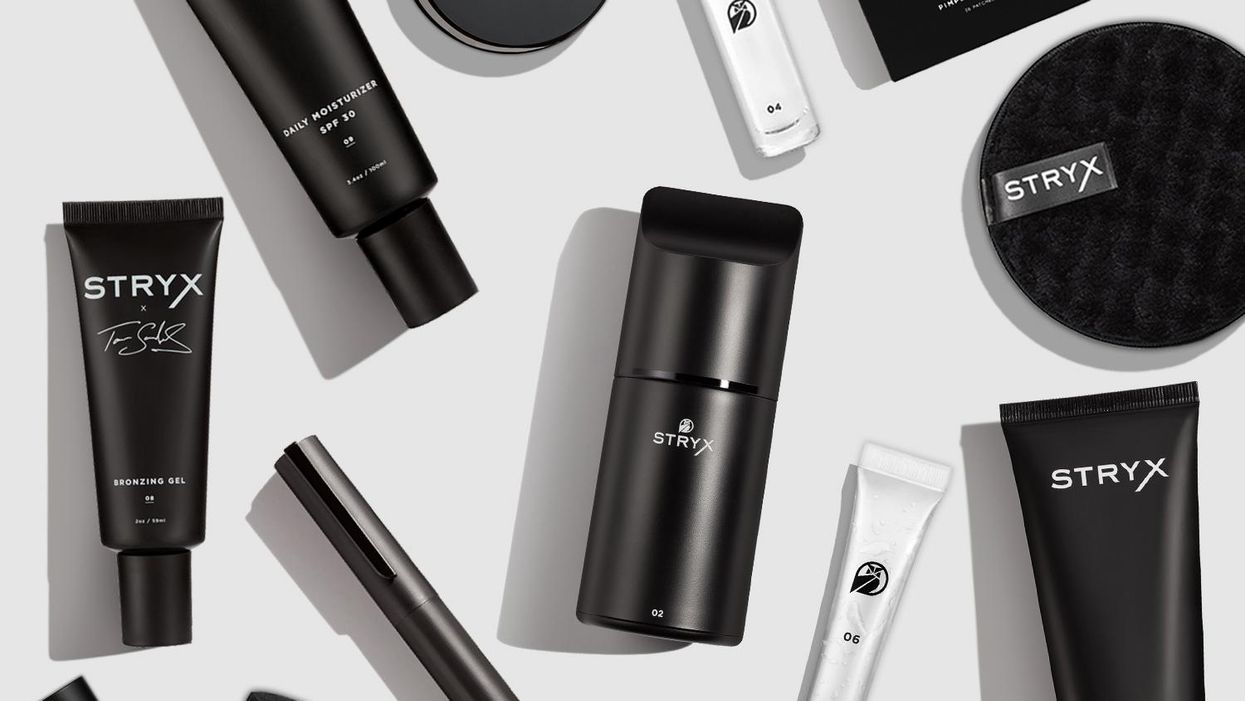Brand News
20 April 2022
Stryx is making space on the shelf for men's cosmetics
Cofounder Jon Shanahan talks about introducing makeup to men through TikTok and an omnichannel approach.

Stryx products. (Courtesy image)
Cofounder Jon Shanahan talks about introducing makeup to men through TikTok and an omnichannel approach.

Stryx products. (Courtesy image)
Great products become a part of shoppers’ lives.
They find their way into routines, and they can be there in a pinch when needed.
Brands set out to create goods that reach this status with their customers. If they are serving a unique function, they could help to shape new categories along the way.
Yet getting to that point requires not just developing unique and effective products. It also requires showing shoppers where those products fit into their days, and even how to use them.
Stryx is on that journey in the area of men’s cosmetics.
The brand was launched in 2019 by Jon Shanahan and Devir Kahan. They both had breakouts on their wedding days, and soon found there was a market for products that could offer a way for men to cover up pimples. They could also apply to blemishes, razor scratches, scars and dark circles.
After completing the XRC Labs accelerator in New York, raising pre-seed and seed funding from investors, and building traction through DTC channels, the company is on a growth trajectory. From a start with concealer and tinted moisturizer, it has added a number of SKUs from lip balm to bronze gel. The most recent is a Deep Java shade of concealer. Stryx is also making a higher volume of products as it gains retail partnerships to appear in stores like Target, which it recently added.
At the same time, Shanahan said in a recent interview that attracting new users to these products is ultimately about tapping into something more fundamental: Showing men that cosmetics are for them.
“I don’t think it goes through most men’s minds that you can put makeup on, or that you can have that instant cover of skin,” Shanahan, the New York-based brand’s CMO, told The Current on the floor of Shoptalk in Las Vegas.
Yet when they have a wedding, first date, presentation or even a Zoom call, many men that Shanahan talks to allow that there’s a moment when they want to enhance their appearance. They just don’t have a product for it, or know how to use cosmetics.
So Stryx’s work is also about building a brand of cosmetics that are made specifically for men "from the ground up," Shanahan said. This includes not just how the products are made and packaged, but also how the brand presents them in education and marketing.
When it comes to formulation, the brand developed products that take into account the differences between how beauty products would perform on men’s and women’s skin. At the same time, Stryx worked with makeup artists to develop products that were easy to apply. Most beauty products have a place in a person’s routine, but men often don’t have that established. So Stryx leaned toward quick application and multiple uses in a single product that men tend to favor.
In the area of packaging, Stryx aimed to make a product that looks cool. Considering what James Bond’s concealer would look like led to a sleek, pen-shaped tool that fits in a pocket.

Stryx concealer. (Courtesy photo)
But having the product that's a match for the audience is just one step. In a market where men aren't necessarily familiar with cosmetics, Stryx must break down preconceived notions about who wears makeup.
“We have to overcome a stigma about these products that guys can’t wear a cosmetic, and the fact that guys don’t know how to use, wear or apply it,” Shanahan said.
One way to do that is to show it to them. For Stryx, TikTok proved to be a great place to do so.
Having previous video experience with YouTube, Shanahan started experimenting with the short-form video platform in 2019, and quickly found it was a great format to show how to use Stryx products. With the brand’s tinted moisturizer, the ability to demonstrate it helped catapult the product.
“It took our worst selling product… to our best selling product,” Shanahan said. “Still to this day, it does very well because it’s a very visual product.”
Now TikTok is a primary driver of the company’s DTC business, both through paid and organic approaches.
Given how the rise of #beautytok has been driven by demos, it makes sense that similar content would bring traction for these types of cosmetics, as well. Shanahan said the platform prioritizes trust that products are what they say they are, and the fact that he is a founder talking about a product only adds to the authenticity.
@stryx_official Reply to @average.coke.enjoyer ♬ original sound - worldofdance
Just as important is how Shanahan talks about them. Rather than a hyper-masculine approach taken by some brands, he is observant of walking a “fine line” of speaking directly to men, but doing so in an inclusive way.
This comes back to building a connection with a shopper, and showing where makeup fits in. While there might not be a routine for men’s cosmetics, Shanahan sees a path that customers follow: Guys start to work out, then they dress better. Then, they might start using skincare products.
“This is the next step of that, which is instantly changing and instantly augmenting your appearance,” he said.
Taking an omnichannel approach also helped the brand become a part of the landscape for men. It launched into 2,000 CVS stores in 2020. Nordstrom.com followed in 2021.
@stryx_official Reply to @cam.ciaga ♬ original sound - Men’s Skincare & Cosmetics
Recently, it partnered with Target, and is set to appear in all 950 of the retailer’s stores. That put Stryx on shelves right alongside the other products that men seek out.
“The fact that we’re saying you can go to Target, and you can buy your grooming essentials, which is your razors, your deodorant and a concealer – that’s a huge validator,” Shanahan said.
The brand optimized production for wholesale from the start, so it had the operations in place to move into big, in-person stores. When it came to getting buy-in from retailers, Shanahan said a pitch resonated that pointed out how men’s cosmetics could bring not just an audience, but also grow a category.
“The shave category is only so big. How do you grow the personal care category? You bring in cosmetics – a product that has never been sold before,” Shanahan said.
More validation has come from spokespeople. The brand partnered with Tom Sandoval, a star of “Vanderpump Rules” on Bravo. ESPN host Gary Striewski is familiar with makeup given his on-camera role, and became known for talking sports while wearing a mask on Snapchat. Now he’s speaking for Stryx, as well.
Seeing prominent personalities on TV use and talk about makeup only helps to normalize makeup for men everywhere.
“Having those more masculine spokespeople is really important," Shanahan said.
On the Move has the latest from Amazon, Lovesac and more.
Ryan Cohen is executive chairman of GameStop. (Photo by Flickr user Bill Jerome, used under a Creative Commons) license.
This week, leadership is changing at GameStop, Sorel and Beautycounter. Meanwhile, key executives are departing at Amazon, Wayfair and Lovesac.
Here’s a look at the latest shuffles:
GameStop announced the termination of Matthew Furlong as CEO on Wednesday. A brief statement did not provide a reason for the firing.
With the move, Chewy founder and activist investor Ryan Cohen was named executive chairman of the video game retailer. Cohen will be responsible for capital allocation and overseeing management.
It came as the company reported a 10% year-over-year decline in net sales for the first quarter. Meanwhile, the company’s net loss improved by 62%.
In an SEC filing, GameStop further added this “We believe the combination of these efforts to stabilize and optimize our core business and achieve sustained profitability while also focusing on capital allocation under Mr. Cohen’s leadership will further unlock long-term value creation for our stockholders.”
Cohen was revealed as GameStop's largest shareholder when he disclosed a 10% stake in the retailer in 2020. GameStop went on to become a leading name in the meme stock rise of 2021.
Mark Nenow is stepping down as president of the Sorel brand in order to focus on his health.
After rising to the role in 2015, Nenow spearheaded a transformation of Columbia Sportswear-owned Sorel from a men’s workwear brand to a fashion-focused brand that led with a women’s offering of boots, sandals and sneakers.
“Mark led the brand to sales of $347 million in net sales in 2022,” said Columbia Sportswear CEO Tim Boyle, in a statement. “His leadership has been invaluable to this company, and we wish him the very best.”
Columbia will conduct a search for Nenow’s replacement. Craig Zanon, the company’s SVP of emerging brands, will lead Sorel in the interim.
Beautycounter appointed board member Mindy Mackenzie as interim CEO, succeeding Marc Rey. According to the brand, Rey and the board “mutually decided to transition to a new phase of leadership for Beautycounter.”
McKenzie, a former executive at Carlyle, McKinsey and Jim Beam, will lead the company as it conducts a search for a permanent CEO. Additionally, former Natura & Co CEO Roberto Marques will join Beautycounter’s board as chair.
As part of the transition, Nicole Malozi is also joining the company as chief financial officer. She brings experience from Tatcha, Nike, and DFS Group Limited.
Melissa Nick, a VP of customer fulfillment for North America at Amazon, will leave the company, effective June 16, CNBC reported. Nick joined the company in 2014, and oversaw a region that included nearly 300 fulfillment centers. After doubling its supply chain footprint during the pandemic, Amazon recently reorganized its fulfillment operations to take a regional approach, as opposed to a national model that often resulted in items shipping across the country.

Jon Blotner (Courtesy photo)
Steve Oblak will retire from the role of chief commercial officer at home goods marketplace Wayfair. With the move, Jon Blotner will be promoted to chief commercial officer.
"Steve has served as a critical part of our leadership team and played a pivotal role in Wayfair's growth, helping us grow from a $250 million business when he joined to $12 billion in net revenue today,” said Wayfair CEO Niraj Shah, in a statement. “He oversaw countless milestones, from helping to launch the Wayfair brand as we brought together hundreds of sites into a single platform, to launching new categories, business lines, and geographies while overseeing our North American and European businesses, to leading our debut into physical retail.”
Blotner previously oversaw exclusive and specialty retail brands, as well as digital media at Wayfair. Before joining the company, he served as president of Gemvara.com prior to its 2016 acquisition by Berkshire Hathaway.
Furniture retailer Lovesac said Donna Dellomo will retire as EVP and CFO, and move to an advisory role, effective June 30. Dellomo was with Lovesac for six years.
Keith Siegner was appointed as the next EVP and CFO. He brings experience as CFO of esports company Vindex, as well as executive roles at Yum! Brands, UBS Securities and Credit Suisse.
Additionally, Jack Krause will retire from the role of chief strategy officer, effective June 30. His responsibilities will be divided between CEO Shawn Nelson and president Mary Fox.
“Since joining Lovesac, Jack has played an instrumental role in transforming the Company into a true omni channel retailer by helping expand our physical touchpoints and digital platform as we continue to disrupt the industry,” said Nelson, in a statement.
The National Retail Federation announced the addition of five new board members. They include: